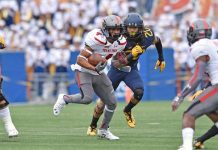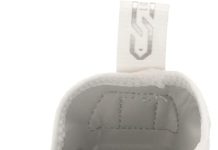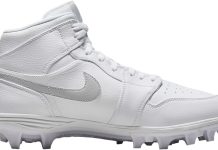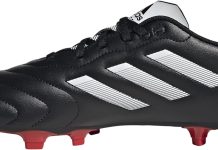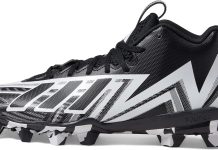Are you uncertain which football cleat is best suited for your position on the field? We understand the dilemma, as selecting the right cleats can significantly impact your performance.
Fortunately, we have compiled a comprehensive guide to help you navigate this important decision.
By considering factors such as field type, playing style, and position-specific requirements, you will be equipped with the knowledge needed to make an informed choice.
So, lace up your boots, and let’s embark on this journey to find the perfect football cleat for you!
Comfort
When choosing the right football cleat, comfort is a crucial factor to consider. After all, you’ll spend significant time in these shoes, running, jumping, and making quick movements on the field. To ensure maximum comfort, there are two main aspects to look for: proper fit and sufficient cushioning and padding.
Review contents
Proper fit
Finding cleats that fit correctly is essential for comfort and performance. Ill-fitting shoes can cause discomfort and blisters and even affect your ability to move efficiently on the field. When trying on cleats, ensure they are snug but not too tight. They should provide enough room for your toes to move but shouldn’t slide around inside the shoe. It’s also crucial to consider specific foot conditions or abnormalities, such as wide feet or high arches, and choose a brand or model that caters to those needs.
Cushioning and padding
Cushioning and padding in football cleats help absorb impact and provide additional comfort during gameplay. Look for shoes with adequate padding around the collar and tongue to prevent chafing and reduce pressure on your feet. Additionally, some cleats come with cushioned insoles or midsoles, which offer extra support and shock absorption. These features can be particularly beneficial for players in high-impact positions involving jumping or cutting movements.
Traction
Traction is another critical aspect to consider when selecting football cleats. The right type of traction can enhance your ability to make quick directional changes, maintain balance, and prevent slipping during gameplay.
Playing surface
Different playing surfaces require different types of cleats. Traditional grass fields, artificial turf, and even indoor surfaces each have specific characteristics that influence the type of cleats required. Molded cleats are generally recommended for natural grass fields as they provide excellent traction and stability. On the other hand, turf shoes or cleats with rubber studs are better suited for artificial turf to prevent damage to the playing surface.
Cleat type
Football cleats can be categorized into three main types: molded, detachable, and turf shoes. Molded cleats have permanently attached studs and are suitable for most playing surfaces and positions. Detachable cleats allow you to change the studs depending on the playing surface, making them versatile but requiring extra preparation. Turf shoes are specifically designed for artificial turf and feature short rubber studs for optimal traction.
Stud shape and length
The shape and length of the cleat studs also play a crucial role in traction. Conical studs are the most common and provide all-around stability and grip. However, different positions may benefit from specific stud configurations. For example, linemen often prefer cleats with extended and broader studs for added traction during pushing and blocking. In comparison, wide receivers may opt for shorter studs for better acceleration and quick direction changes.
This image is the property of images.unsplash.com.
Ankle Support
For players looking to enhance their ankle support, choosing the right style of cleats is essential. There are three main types: high-top, mid-top, and low-top cleats.
High-top cleats
High-top cleats rise above the ankle and provide the most support. They offer stability and help prevent ankle injuries, making them popular among linemen and players who frequently make pivoting movements. However, some players may find high-top cleats too restrictive or heavy, impacting their agility on the field.
Mid-top cleats
Mid-top cleats provide a balance between ankle support and flexibility. They cover a portion of the ankle, offering moderate support without limiting mobility. These cleats are often preferred by running backs and linebackers who require both agility and stability.
Low-top cleats
Low-top cleats offer minor ankle support but maximum mobility and flexibility. They are lightweight and suitable for players who prioritize speed and quick movements, such as wide receivers and defensive backs. However, it’s important to note that the trade-off for increased agility is a higher risk of ankle injuries.
Position-specific cleats
Different football positions require specific features in cleats to optimize performance. Here are some position-specific considerations when selecting your cleats:
Quarterbacks
Quarterbacks benefit from cleats that provide good traction for quick starts and stops. Look for lightweight cleats that offer optimal maneuverability. Additionally, cleats with a good balance between stability and flexibility will aid in making precise throws and maintaining balance during gameplay.
Running backs
Running backs require cleats that provide excellent traction and support for quick acceleration, cutting, and lateral movements. Look for cleats with aggressive traction patterns that can grip the turf and sufficient ankle support for added stability during impact.
Wide receivers
Wide receivers rely on their speed and agility, so lightweight and low-top cleats are often preferred. Cleats with a snug fit and good traction help them make quick cuts and create separation from defenders. Comfort and flexibility are also crucial for receivers to maintain a full range of motion.
Linemen
Linemen require outstanding traction and stability cleats to generate power and hold their ground. Look for cleats with longer, wider studs that offer maximum grip on grass or turf. Additionally, highly durable materials and reinforced features, such as toe caps, can withstand the intense physicality of the position.
Linebackers
Linebackers must be agile, explosive, and have solid traction during tackles or direction changes. Cleats with mid-top or high-top ankle support can provide the necessary stability, while good grip and flexibility are essential for quick reactions.
Defensive backs
Defensive backs rely on speed, agility, and the ability to change direction rapidly. Low-top cleats with good traction and lightweight construction are ideal for their position. Ankle flexibility is crucial for defensive backs to stick with receivers and defend against the pass.
Kickers and punters
Kickers and punters often require cleats with a minimalist design and lightweight construction. Look for cleats that provide a glove-like fit, which can enhance accuracy and control when kicking the ball. Focusing on traction and stability during plant foot movements is also essential for these specialized positions.
This image is the property of images.unsplash.com.
Material
The material used in constructing football cleats can impact their durability, performance, and overall feel. While personal preference often plays a significant role, here are the three primary materials to consider:
Synthetic materials
Many modern football cleats use synthetic materials, such as thermoplastic polyurethane (TPU) or synthetic leather. Synthetic cleats are lightweight, durable, and resistant to water absorption. They often offer good traction and provide a more consistent fit than natural materials.
Leather
Leather cleats have long been favored for their natural feel and ability to conform to the foot over time. Genuine leather cleats offer excellent comfort, breathability, and durability. However, they can be heavier than synthetic options and may require more maintenance to keep them in optimal condition.
Mesh
Mesh cleats are known for their breathability and lightweight nature. They provide excellent comfort and ventilation, making them ideal for hot weather conditions. The downside is that mesh materials may not offer the same durability and protection as synthetic or leather cleats.
Budget
When shopping for football cleats, it’s essential to consider your budget. Cleats can vary significantly in price, depending on brand, materials used, and additional features. However, it’s crucial to strike a balance between price and quality. While choosing the most affordable option may be tempting, investing in a higher-quality pair of cleats can provide better performance and durability and ultimately save you money in the long run.
Consider your budget
Determine how much you are willing to spend on football cleats. Setting a realistic budget that aligns with your needs and expectations is essential. Consider factors such as the frequency of use, the level of competition you play at, and how long you expect the cleats to last.
The balance between price and quality
While it’s important to stay within your budget, it’s equally vital to consider the quality of the cleats. Look for reputable brands that offer a good balance between price and quality. Investing in well-crafted cleats can improve your performance, reduce the risk of injury, and provide a more enjoyable playing experience.
This image is the property of images.unsplash.com.
Brand
Selecting a reputable brand is crucial when choosing football cleats. Brands known for their expertise in sports footwear are more likely to provide high-quality products tested and trusted by athletes at all levels. Here are some factors to consider when evaluating different brands:
Consider reputable brands
Look for brands with a strong presence in the football world and a history of producing reliable cleats. Nike, Adidas, Under Armour, Puma, and New Balance are just a few examples of reputable brands that consistently offer a wide range of cleats for various positions and playing styles.
Research customer reviews
Reading customer reviews and ratings can provide valuable insights into different cleat models’ quality, comfort, and durability. Pay attention to feedback from players in your specific position and playing level. This can help you gauge a particular brand or model’s performance in real-world game situations.
Proper Sizing
The correct size is crucial for comfort, performance, and injury prevention. Ill-fitting cleats can cause discomfort and blisters and hinder your ability to move effectively on the field. Here are some tips to help you find the right size:
Measure your foot
Start by measuring the length and width of your foot using a measuring tape or ruler. Use the measurements to refer to the sizing charts provided by the cleat manufacturer. Remember that sizes may vary between brands, so it’s essential to consult the specific sizing information for the cleats you’re interested in.
Consider shoe width
In addition to length, shoe width is essential when selecting cleats. Different brands offer varying width options, such as narrow, medium, or wide. If you have wider feet, choosing a wider width can prevent discomfort and provide a better fit.
Sizing charts
Sizing charts provided by cleat manufacturers can be valuable resources. They often provide measurements for both length and width, helping you determine the most appropriate size. When in doubt between two sizes, using the slightly larger size is generally recommended for better comfort.
Break-in Period
Football cleats often require a break-in period to ensure optimal comfort and performance. The break-in period is when the cleats conform to your foot shape and the materials soften. Here are some considerations regarding the break-in period:
Consider the break-in period
Understand that new cleats may feel stiff and uncomfortable during the first few uses. This is normal and should be expected, especially with cleats made from genuine leather. The break-in period molds the cleats to your feet, providing a better fit and enhanced comfort.
Time to adjust to the cleats
Be patient and give your cleats enough time to adjust to your feet. Don’t be discouraged if they initially feel tight or cause minor discomfort. Gradually increase the duration and intensity of your wear to allow the cleats to soften and become more flexible. This can help prevent blisters and other foot irritations.
Personal Preference
Finally, personal preference plays a significant role in choosing the right football cleats. While factors such as fit, traction, and ankle support are crucial, don’t forget to consider your style and preferences.
Color and design
Many cleats come in various colors and designs, allowing you to express your style on the field. Whether you prefer bold, eye-catching designs or classic, understated colors, choose a pair of cleats that make you feel confident and comfortable during gameplay.
Shoe weight
Weight can impact your overall performance on the field, especially if you value speed and agility. Some players prefer lightweight cleats for increased mobility, while others prefer slightly heavier ones for added stability. Experiment with different weights and assess how they affect your performance to find the optimal balance for your playing style.
In conclusion, choosing the right football cleats involves considering several factors such as comfort, traction, ankle support, position-specific features, material, budget, brand reputation, proper sizing, break-in period, and personal preference.
By understanding and evaluating these aspects, you can make an informed decision that enhances your comfort, performance, and enjoyment on the football field. Remember, the right cleats can make a significant difference in your game, so take your time, try different options, and prioritize finding the perfect fit for your feet and playing style.








